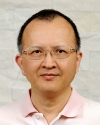楊大衍 博士 (生物物理與分析技術組)
最新研究成果
Sheh-Yi Sheu,* Hua-Yi Hsu, and Dah-Yen Yang*
Advanced Intelligent Systems, 3(7):2000273 (2021).
Quantum computers adopt an n-state quantum mechanical system to manipulate the superposition state. However, molecular transistors have not been used to build up the quantum logic gate. Here, we demonstrate that DNA, RNA and protein are promising media for quantum computers, and one could employ residue pairs, including nucleotide base pairs and amino acid pairs, via proton-coupled electron transfer to fabricate a quantum logic gate. In the residue pair, the proton transfer between donor and acceptor states fulfill a qubit. Both the DNA-CG (3-qubit) nucleobase pair and nucleotide base pair obey the Toffoli gate. AT (2-qubit) nucleotide base pair behaves as a SWAP gate and a CNOT gate. Furthermore, the AU and RNA-CG nucleotide base pairs follow the CNOT gate and Toffoli gate, respectively. In addition, a pair of amino acids achieves 1-qubit and satisfies the Pauli-X, -Y and -Z gates. The generators of universal quantum logic gates are obtained. We demonstrate that quantum computers are constructed by molecular transistors in the size of one nanometer, and DNA, RNA and protein residue pairs are used to make universal quantum logic gates. The double helix of the nucleic acid is a quantum computer. These results provide a new perspective in topological quantum computers.
目前位置:本所人員 / 研究人員/ 楊大衍
中央研究院 原子與分子科學研究所版權所有 |
個人隱私權聲明 |
保有個資檔案公開項目彙整表 |
行動版
地址: 106319 台北市羅斯福路四段一號 或 106923 臺北臺大郵局 第23-166號信箱
電話:886-2-2362-0212 傳真:886-2-2362-0200 電子郵件:iamspublic@gate.sinica.edu.tw
最後更新於 2024-04-22 22:44:49
地址: 106319 台北市羅斯福路四段一號 或 106923 臺北臺大郵局 第23-166號信箱
電話:886-2-2362-0212 傳真:886-2-2362-0200 電子郵件:iamspublic@gate.sinica.edu.tw
最後更新於 2024-04-22 22:44:49
 中央研究院 原子與分子科學研究所
中央研究院 原子與分子科學研究所

